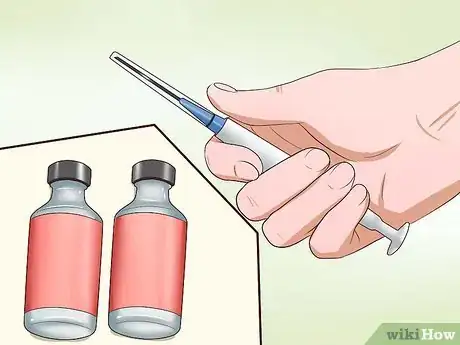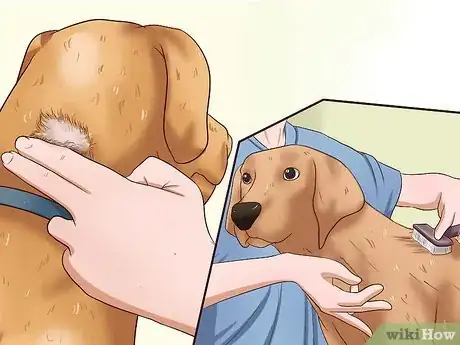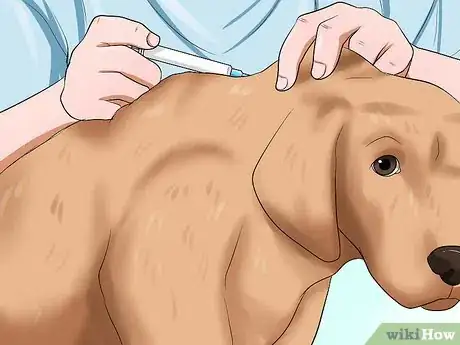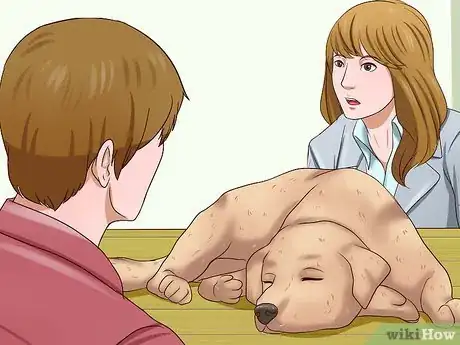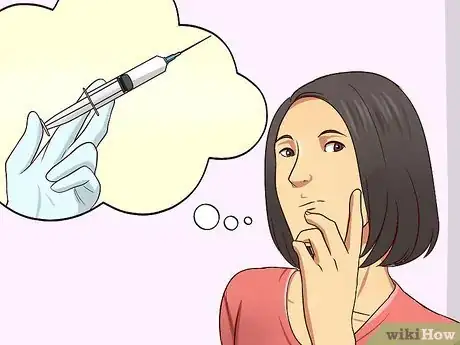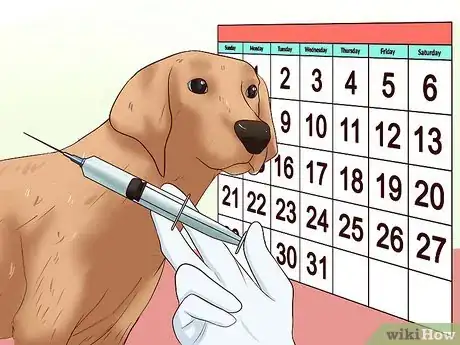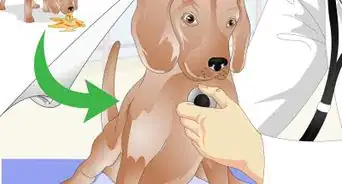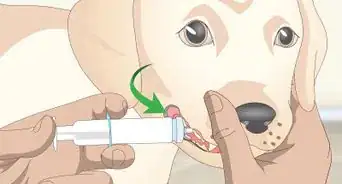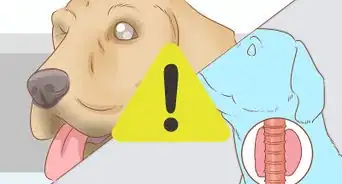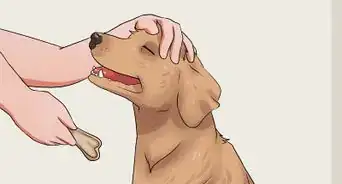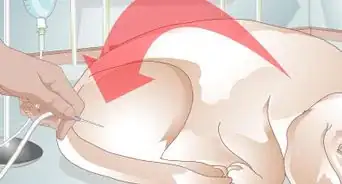This article was co-authored by Ray Spragley, DVM and by wikiHow staff writer, Jessica Gibson. Dr. Ray Spragley is a Doctor of Veterinary Medicine and the Owner/Founder of Zen Dog Veterinary Care PLLC in New York. With experience in multiple institutions and private practices, Dr. Spragley’s specializations and interests include non-surgical management of cranial cruciate ligament tears, Intervertebral Disk Disease(IVDD), and pain management in osteoarthritis. Dr. Spragley holds a BS in Biology from SUNY Albany and has a Doctor of Veterinary Medicine degree (DVM) from Ross University School of Veterinary Medicine. He is also a Certified Canine Rehabilitation Therapist (CCRT) through the Canine Rehab Institute as well as a Certified Veterinary Acupuncturist (CVA) through Chi University.
This article has been viewed 197,262 times.
You can save a lot of time, money, and energy by vaccinating your dog at home. As long as you know the correct procedure and follow basic guidelines, vaccinating at home can be simple and safe. However, you need to make sure your dog is first thoroughly examined by a veterinarian and is healthy. Vaccines should also be stored and handled properly to prevent health problems for your pet.
Steps
Giving the Vaccine
-
1Prepare the injection. Check the vaccines to make sure they've been properly transported and stored at the temperature on the label. You may need to mix vaccines. If so, there will be two vials that you'll need to combine according to the label instructions. Once mixed, draw back all of the solution into the syringe and remove excess air bubbles by tapping on the side of the syringe. The needle should be pointing up.[1]
- Most vaccines will need to be stored at normal refrigeration temperatures.
- Make sure you use a new needle that's sharp when you give the vaccine.[2]
-
2Prepare the dog. Make sure the dog is clean so that no dirt is visible around the loose skin on the neck. His fur should be dry before you vaccinate. Lift up the back of the dog's skin near the neck to make a tent.[3] This gives you a pocket of space underneath the skin where you can inject the vaccine.[4]
- Unlike humans, you don't need to prepare the site with an alcohol wipe.
Advertisement -
3Insert the syringe. Hold the syringe level with the dog's back and place the needle with the bevel (flat part of the needle) along the tented skin. Gently puncture the skin with the needle and draw back on the syringe. Slowly press on the syringe plunger to give the vaccine.[5]
- If you see blood in the needle, you will need to find another location to give the injection. Blood in the needle means you’ve hit a blood vessel and you cannot give a vaccine into a blood vessel.
-
4Remove the needle. Once you've taken out the needle, apply pressure on the site for about 30 seconds. This will prevent bleeding. Place the needle and syringe in an appropriate garbage receptacle or in a glass jar to be disposed of at a veterinary clinic.[6]
- Never put an uncapped needle into the garbage since people who work at landfills could get injured.
Taking Precautions
-
1Get the dog examined by the veterinarian. You'll need to take the dog in for a thorough medical examination.[7] The vet will determine whether the dog is healthy enough to be vaccinated at home. If the dog has a compromised immune system or is sick, giving a vaccine will only make him sicker or cause the vaccine to be ineffective.
- While you can vaccinate the dog against a variety of diseases, you cannot give the rabies vaccine. The rabies vaccine must always be given by a veterinarian.[8]
EXPERT TIPDr. Elliott, BVMS, MRCVS is a veterinarian with over 30 years of experience in veterinary surgery and companion animal practice. She graduated from the University of Glasgow in 1987 with a degree in veterinary medicine and surgery. She has worked at the same animal clinic in her hometown for over 20 years.Veterinarian
 Pippa Elliott, MRCVS
Pippa Elliott, MRCVS
VeterinarianPippa Elliott, a licensed veterinarian, explains: "The importance of a yearly (at least!) checkup should not be underestimated. It allows the vet to establish a normal weight for the pet, and spot trends such as weight loss or gain. It's also a chance to look for changes that could indicate a health problem is brewing, or to establish what's normal for that dog when they're well."
-
2Recognize reactions to vaccines. While it's rare for a dog to have a reaction to a vaccine, it's important to recognize possible reactions. Your dog may have swelling at the injection site, mild fever, decreased energy or appetite, sneezing or some coughing.[9] One of the worst reactions is anaphylactic, a life threatening reaction that needs immediate medical treatment. If you notice your dog is having trouble breathing, has a slow heart rate or low blood pressure, see the vet right away. [10] If your dog has a slow heart rate or low blood pressure, he may become unusually drowsy, may seem weak or drunken and then collapse, all within 20-30 minutes.
- Most vaccines for animals are given just below the skin (subcutaneously) to reduce pain and possible reactions.
- If your pet has ever had a reaction to a vaccine, no matter how minor, do not attempt to give a vaccine of any type at home in case of a severe reaction.
-
3Understand the basics of vaccines. A vaccine works by imitating a viral or bacterial infection. It does this by stimulating the body’s immune system to produce cells that fight the virus or bacteria. This prepares the immune system for future encounters with the virus or bacteria. So, if the vaccinated dog comes into contact with the virus or bacteria, his immune system will remember how to fight the infection, producing cells to fight off the virus or bacteria.[11]
- The vaccine does not actually infect the dog, it only imitates the virus or bacteria, though the dog might have a slight reaction (like mild rash or fever).
-
4Follow a vaccination schedule. Many vaccines need an initial series of two vaccines given 3 to 4 weeks apart. This makes sure the immune system is working. After this, the dog will need an annual or 2 to 3 year booster shot of the vaccine to keep his vaccine status updated.
- Each vaccination has its own timeline, so talk with the vet to determine the timing of vaccinations for your pet.[12]
Expert Q&A
-
QuestionHow far does a vaccine needle go into the skin?
 Ray Spragley, DVMDr. Ray Spragley is a Doctor of Veterinary Medicine and the Owner/Founder of Zen Dog Veterinary Care PLLC in New York. With experience in multiple institutions and private practices, Dr. Spragley’s specializations and interests include non-surgical management of cranial cruciate ligament tears, Intervertebral Disk Disease(IVDD), and pain management in osteoarthritis. Dr. Spragley holds a BS in Biology from SUNY Albany and has a Doctor of Veterinary Medicine degree (DVM) from Ross University School of Veterinary Medicine. He is also a Certified Canine Rehabilitation Therapist (CCRT) through the Canine Rehab Institute as well as a Certified Veterinary Acupuncturist (CVA) through Chi University.
Ray Spragley, DVMDr. Ray Spragley is a Doctor of Veterinary Medicine and the Owner/Founder of Zen Dog Veterinary Care PLLC in New York. With experience in multiple institutions and private practices, Dr. Spragley’s specializations and interests include non-surgical management of cranial cruciate ligament tears, Intervertebral Disk Disease(IVDD), and pain management in osteoarthritis. Dr. Spragley holds a BS in Biology from SUNY Albany and has a Doctor of Veterinary Medicine degree (DVM) from Ross University School of Veterinary Medicine. He is also a Certified Canine Rehabilitation Therapist (CCRT) through the Canine Rehab Institute as well as a Certified Veterinary Acupuncturist (CVA) through Chi University.
Veterinarian Not necessarily! Most dog vaccines are given subcutaneously—this means that they go directly beneath the skin but not deep enough to hit a muscle.
Not necessarily! Most dog vaccines are given subcutaneously—this means that they go directly beneath the skin but not deep enough to hit a muscle.
Warnings
- Do not administer a vaccine if your dog may be ill or has a compromised immune system. If your dog has had any diarrhea or vomited, do not administer the vaccine.⧼thumbs_response⧽
- Make sure all materials used are sterile and follow sterile procedures. Never use materials that haven't been sterilized.⧼thumbs_response⧽
- Only give vaccines recommended by your veterinarian.⧼thumbs_response⧽
- Do not give vaccines by IV.⧼thumbs_response⧽
- Purchase vaccines from a registered vendor to ensure proper storage.⧼thumbs_response⧽
References
- ↑ http://www.bu.edu/animalcare/procedures/injection-techniques/subcutaneous/
- ↑ Ray Spragley, DVM. Veterinarian. Expert Interview. 19 August 2021.
- ↑ Ray Spragley, DVM. Veterinarian. Expert Interview. 19 August 2021.
- ↑ http://www.bu.edu/animalcare/procedures/injection-techniques/subcutaneous/
- ↑ http://www.bu.edu/animalcare/procedures/injection-techniques/subcutaneous/
- ↑ http://www.bu.edu/animalcare/procedures/injection-techniques/subcutaneous/
- ↑ Ray Spragley, DVM. Veterinarian. Expert Interview. 19 August 2021.
- ↑ http://www.petmd.com/dog/care/evr_vaccinating_your_own_dog
- ↑ https://www.avma.org/public/PetCare/Pages/What-to-expect-after-your-pets-vaccination.aspx
